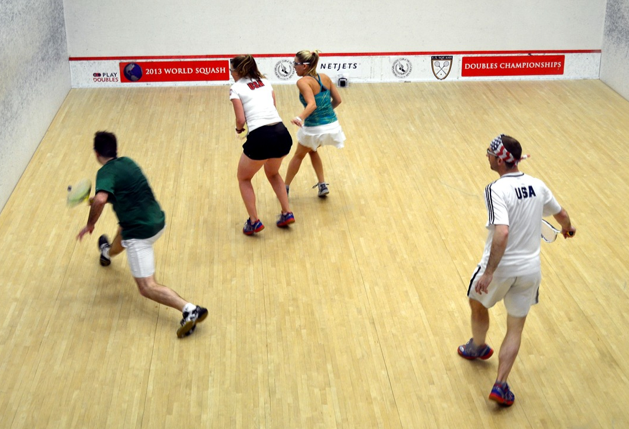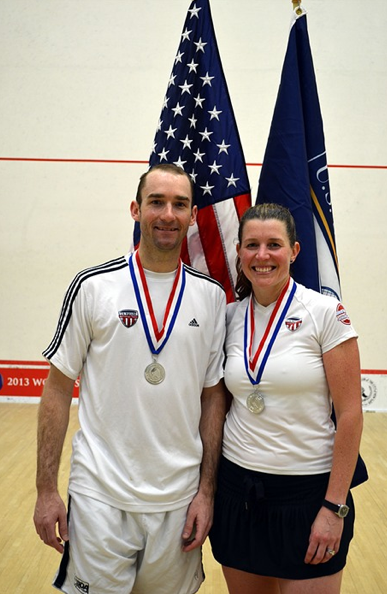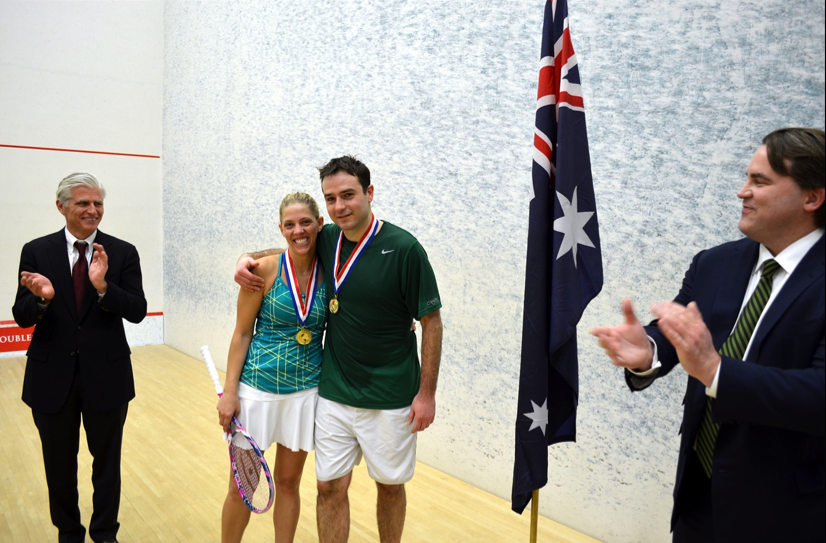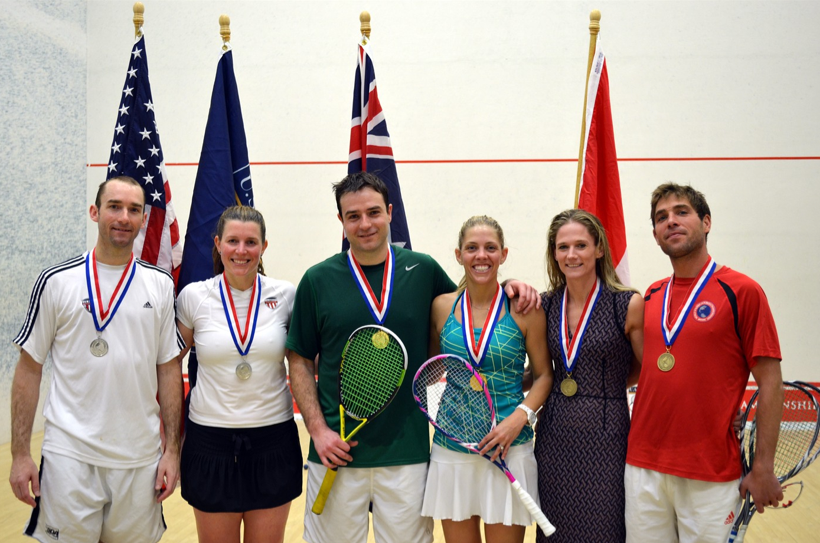The 2013 World Doubles Championships mixed finals played out on Saturday evening at the New York Athletic Club, with Australian team Paul Price and Narelle Krizek crowned the Richmond Mixed Open World Doubles champions.
The intense four-game match fell smoothly in favor of the Aussies in the first two games, 15-7, 15-6, but US opponents Preston Quick and Natalie Grainger climbed back in the third from 10-6 down to take the game 15-10. However the Americans narrowly missed out on evening up the stakes in the forth, going down 15-13 in a nail biting finish to the match.
In the play off for third and forth place, Canadians Viktor Berg and Stephanie Hewitt defeated American team Dana A. Betts and Gregory O. Park in four games (15-14, 11-15, 15-10, 15-9).
Tracy Gates, a passionate squash fan and player who lives in New York City and writes about squash on her blog, Squeaky Feet, gives her account of the final…
____________________
Mixed Doubles Served with a Twist
Like most of us, I love a good story. But I quickly lose interest if it looks like it’s going in one direction—in a straight line, no swerves, no bumps. If it were up to me, I’d make the writer revise. Put in a twist. Start over even. But when the subject is real and a sport, it’s up to the players to revise, to see that the story needs to change tack, to improvise, even if it risks everything. This is the kind of story I saw last night at the Mixed Doubles finals in the World Doubles Championships at the New York Athletic Club. But before I get to the twist, let’s start at the beginning…
A number of people had told me how impressive the mixed doubles draw was for this tournament. And it was . . . chock full of players who are at the top of their game in doubles or are heading that way. While watching a particularly dramatic point during a quarter finals match on Thursday between teammates Amanda Sobhy and Steven Scharff and opponents Stephanie Hewitt and Viktor Berg, I turned to a friend and exclaimed, “this could be the finals match!” It was that close and that good. So I was really excited to see who was better than that good to make it to the finals.
 On Saturday night, I pull my chair up close to the railing above the NYAC court to see Australian team and number one seeds Narelle Krizek and Paul Price face off against team USA and third seeds Preston Quick and Natalie Grainger. Other than the fact that Quick and Grainger had knocked off #2 seeds Hewitt and Berg with some fantastic shooting that their talented opponents just weren’t able to match, the meet-up made sense and I was anticipating a really good final. Krizek and Price seem like a match made in Aussie heaven; they’re both dangerous shooters, have a full arsenal of weaponry they are expert at using, and know the court well. The only weakness I see is in Krizek, as she was clearly suffering in the semis from either allergies or a cold or maybe both. April in NYC is not kind to noses. But Krizek is playing the right wall, where she is more at home. Quick and Grainger look like the lesser pairing on paper (and Quick is taking a bit of a risk by playing on the left wall), but both have a ton of tenacity, talent, and smarts to slice that paper to shreds. I’m betting on a very close match, despite my friends and neighbors in the stands betting on team Australia.
On Saturday night, I pull my chair up close to the railing above the NYAC court to see Australian team and number one seeds Narelle Krizek and Paul Price face off against team USA and third seeds Preston Quick and Natalie Grainger. Other than the fact that Quick and Grainger had knocked off #2 seeds Hewitt and Berg with some fantastic shooting that their talented opponents just weren’t able to match, the meet-up made sense and I was anticipating a really good final. Krizek and Price seem like a match made in Aussie heaven; they’re both dangerous shooters, have a full arsenal of weaponry they are expert at using, and know the court well. The only weakness I see is in Krizek, as she was clearly suffering in the semis from either allergies or a cold or maybe both. April in NYC is not kind to noses. But Krizek is playing the right wall, where she is more at home. Quick and Grainger look like the lesser pairing on paper (and Quick is taking a bit of a risk by playing on the left wall), but both have a ton of tenacity, talent, and smarts to slice that paper to shreds. I’m betting on a very close match, despite my friends and neighbors in the stands betting on team Australia.
But in the first game, my friends look to be right. Price hits the ball so insanely hard that he immediately puts Quick and Grainger on the defensive, forcing an out-of-court shot by Quick and a tin by Grainger to get the first two points for Australia. Although Price proves he’s still human by tinning a reverse corner, giving USA their first point. The teams trade points to 2-3 AUS, but that’s as close as USA gets the rest of this game. Price and Krizek rack up the points quickly, Krizek putting the ball just enough above Quick’s head, making it hard for him to shoot, and then Price shooting whenever he has the opportunity, which is often. And Price’s shots are truly priceless. This guy shoots like he’s been on the range all day, every day. There doesn’t seem to be a place he can’t fire from . . . and the shots are often delivered with so much force that if I were on court, I’d be cowering low in a corner. To Grainger and Quick’s credit, however, they’re standing up and fighting back. But it’s clearly from a defensive stance. The points they do get are often errors made by the Aussies. At 11-5, Krizek swings and totally misses a ball that breaks on the right wall seemingly long after her racquet goes by. She laughs, exclaiming, “I thought it was coming at me a lot faster than that!” But besides missing a drop shot from back of court, she doesn’t make a lot of errors, and when Price slams a serve at Grainger at 14-7 AUS, Grainger puts the ball straight into the tin to give the Australians a very solid first game at 15-7.
 The second game spools out almost as if someone pressed ‘replay’ of the first. Grainger deftly crosses the ball into the left corner for an early USA point, but the speed of Price’s shots is so unrelenting that there are fewer shooting opportunities for either Grainger or Quick. They’re both on defense, just getting a racquet on the ball seems like an achievement. And their looser returns make for easy targets for Price. Even a cross court by Krizek at 7-3 AUS gets past a too slow Quick. She tins to end the next point, but Price more than makes up for it, powering the ball past Quick on the left wall for a point, and then delivering a pretty corner for another. At 10-4 AUS, Price slips in a rare miss on a drop from the back, and Grainger brings their side up to 6-10 with a neat and lovely corner. As if in response, Price winds up, waiting for the ball to come off the back wall and puts it right into Grainger’s leg. In honesty, I’m sure that he was as surprised as she was that she was in the way . . . yet another reason I’d rather walk over hot coals, rather than worry all match that a Price powershot might be coming straight at me. Whether he truly worries her or not (and Grainger is too cool to let it show), Price and Krizek get the rest of the points in speedy succession, and I’m sure to Grainger’s dismay, Price aces his last serve of the game yet again. I could almost hear Grainger growl…. Game two: 15-6 Australia.
The second game spools out almost as if someone pressed ‘replay’ of the first. Grainger deftly crosses the ball into the left corner for an early USA point, but the speed of Price’s shots is so unrelenting that there are fewer shooting opportunities for either Grainger or Quick. They’re both on defense, just getting a racquet on the ball seems like an achievement. And their looser returns make for easy targets for Price. Even a cross court by Krizek at 7-3 AUS gets past a too slow Quick. She tins to end the next point, but Price more than makes up for it, powering the ball past Quick on the left wall for a point, and then delivering a pretty corner for another. At 10-4 AUS, Price slips in a rare miss on a drop from the back, and Grainger brings their side up to 6-10 with a neat and lovely corner. As if in response, Price winds up, waiting for the ball to come off the back wall and puts it right into Grainger’s leg. In honesty, I’m sure that he was as surprised as she was that she was in the way . . . yet another reason I’d rather walk over hot coals, rather than worry all match that a Price powershot might be coming straight at me. Whether he truly worries her or not (and Grainger is too cool to let it show), Price and Krizek get the rest of the points in speedy succession, and I’m sure to Grainger’s dismay, Price aces his last serve of the game yet again. I could almost hear Grainger growl…. Game two: 15-6 Australia.
When I look down into the court for game three, something is different and the crowd notices the reason before I do. My own confused brain only registers that Price is now serving from the right, which seems odd, because why serve first to Quick? Only it’s not Quick returning; it’s Grainger. She and Quick have switched sides, and why not? Quick is solid on the left wall, but to do any damage in this situation, he belongs on the right. And with two games down, the change-up seems both gutsy and smart. Although not at first. Or second, third, fourth, or fifth points, which they lose in quick succession, making us doubt the wisdom of this bold move. At 5-0 AUS, Krizek tins a straight kill shot and the Americans slowly use this small glimmer of hope to creep back into the game, forcing some errors at first until Quick places some reverse corners into open air; Price and Krizek aren’t even close. At 7-10 Australia, I write down ‘come back??’ and USA answers by not letting up. They’ve switched burners and turned it up high. Grainger is hitting absolutely beautiful drops and Quick ‘s responses to Price’s speed are much more sure. Now up 12-10 USA, Quick takes a faster than a speeding bullet ball by Price and lays it right down for a neat drop. My mouth gapes open. In familiar words not mine, ‘the times they are a-changin’.’ And this time Grainger doesn’t hit a tin in the last point, Krizek does. The USA team came from being down 10-5 to charging through ten points without a lapse. There’s a twist for you. Game three 15-10 USA.
Game four starts as solidly for USA as game three ended. They’re using the classic set-up—lots of high lobs, followed by well-timed and placed low shots. Grainger gets the first point with a pretty backhand volley drop, and Quick follows with a volley drop for the second point. But there the twelve point streak ends, as Australia finally decides to even the score; they’re not going to let this game be a repeat of the third. Narelle I know to be tenacious, and Price surely has his pride to protect. Despite some great leaps and gets by Quick, the Australian teammates put the pressure on and pull ahead, again to 10-5 AUS. But as Grainger puts together two backhand volley drops in a row, I’m sure the crowd wonders if USA can do it again. If they can, it’s not going to be the same scenario, however, as Price and Krizek add more defense and force some USA mishits. Both teams creep forward, with Australia always three or four points ahead. At 13-10 AUS, Price seems ready to end it; he challenges a let call, assuming the point should be his, but it’s sustained and he responds by quickly hitting a winner into a vacant corner for 14-10 AUS match point.
 If I’d only seen the first two games and gone for dinner during the third, then I’d be singing ‘sayonara USA’ just now. But I know better. Next ball Price hits out of court. 14-11. Quick gets the next 12-14. And Grainger delivers a satisfying left corner drop for 13-14! Oh. My.
If I’d only seen the first two games and gone for dinner during the third, then I’d be singing ‘sayonara USA’ just now. But I know better. Next ball Price hits out of court. 14-11. Quick gets the next 12-14. And Grainger delivers a satisfying left corner drop for 13-14! Oh. My.
But sometimes a good game, as with a good story, comes with a twist. And this one occurs when the ball comes down the left wall, heads for the back and Grainger twists to her left to follow it. “Around!’ she yells, turning and expecting, I assume, to hit a forehand as the ball comes around to her right. Only Quick is there, too. In that millisecond of minds deciding who should hit, no one does. The ball drops. The game and match end. 15-13 Australia. Three games to one. And a truly great doubles match with two twists.
I wonder, as I watch the awards ceremony, if I’ll ever see a rematch by these two excellent teams. And what would’ve happened if Quick and Grainger had set their plan in motion sooner. But that’s what stories are, even in squash, you live them and you learn from them. I can’t wait for the next one to be told.


